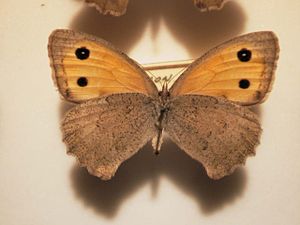Little ox eye
| Little ox eye | ||||||||||||
|---|---|---|---|---|---|---|---|---|---|---|---|---|

Lesser ox-eye ( Hyponephele lycaon ) |
||||||||||||
| Systematics | ||||||||||||
|
||||||||||||
| Scientific name | ||||||||||||
| Hyponephele lycaon | ||||||||||||
| ( Rottemburg , 1775) |
The Small Meadow Brown ( Hyponephele lycaon ) is a butterfly of the subfamily of Julia Butterfly (Satyrinae).
features
The little ox-eye has a wingspan of 36 to 42 millimeters (37 to 43 mm). The species shows a sexual dimorphism : the male has a spot with scented scales on the upper side of the front wing , the female has two black eye spots on the front wing .
The very agile green caterpillar has a unique two-tone side stripe: red above, white below.
Way of life and distribution
The moths fly from June to September (August). Only one generation flies each year. The distribution area extends from northern Portugal and Spain (except south-west Spain) through southern France and the Alpine region to Eastern Europe including the Baltic Sea region and Central Asia . The northern limit of distribution used to run at about 62 degrees north through southern Finland, where the species was registered for a longer period from 1823 to 1936. Since then, however, she has disappeared there. The north-western border in Germany runs roughly through the Hamburg area, where the moths were not uncommon to be found in the Fischbeker Heide in 1953 and 1954. The species is now threatened with extinction there. In addition, the small ox-eye was registered in Holstein in many places, whereby it is assumed that the moths immigrated from Mecklenburg.
The little ox-eye is a preferred continental species and loves dry, warm, steppe-like or bushy, grassy patches between rocks. It flies relatively fast and just above the ground. Sitting on the ground with folded wings, it is very well camouflaged. When foraging for food, flowering plants such as scabiosis are preferred.
The female attaches the fairly large eggs to grasses such as bluegrass , fescue ( Festuca ) or erect bromus ( Bromus erectus ).
Individual evidence
- ↑ a b c d I. Novak, F. Severa. The cosmos butterfly guide . Stuttgart 1985 ISBN 3-440-04774-1 p. 118
- ^ Ottokar Kudrna: The Distribution Atlas of European Butterflies. Apollo Books, Stenstrup, ISBN 87-88757-56-0
- ^ Günter Ebert (Ed.): The butterflies of Baden-Württemberg. Volume 2. Tagfalter II (Augenfalter (Satyridae), Bluebirds (Lycaenidae), Dickkopffalter (Hesperiidae)). Ulmer Verlag Stuttgart 1993. ISBN 3-8001-3459-4
literature
- Roland Gerstmeier. Which butterfly is that? Kosmos-Naturführer, Franckh-Kosmos Stuttgart 2008 ISBN 978-3-440-11558-9
Web links
- Lepiforum e. V. Taxonomy and Photos
- Fauna Europaea, taxonomy (English)